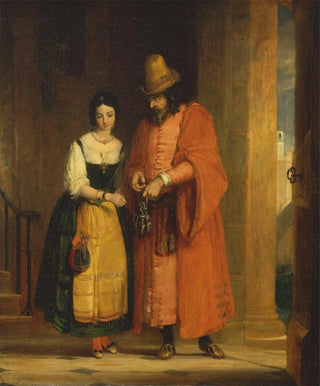Art print | Shylock and Jessica from The Merchant of Venice II ii - Gilbert Stuart Newton


View from behind

Frame (optional)
In the fascinating world of Shakespearean theater, the art print "Shylock and Jessica from The Merchant of Venice II ii" by Gilbert Stuart Newton stands out as an evocative tableau, capturing the very essence of human tensions and conflicting emotions. This iconic scene, taken from William Shakespeare's play, immerses the viewer in a pivotal moment where love and betrayal intertwine in a game of glances and gestures. The art print of this work not only allows for a renewed appreciation of the depth of relationships between the characters but also offers an exploration of the richness of an era when art and literature intertwined to create timeless stories.
Style and uniqueness of the work
Gilbert Stuart Newton's style is distinguished by its romantic approach and vibrant colors that breathe new life into the characters he depicts. In "Shylock and Jessica," facial expressions and postures of the two protagonists reveal palpable tension, oscillating between Jessica's sincere love and Shylock's anxiety. The choice of colors, ranging from warm tones to darker shades, emphasizes the underlying drama of the scene. Newton manages to capture not only the present moment but also the soul of the characters, making the tableau profoundly human. Every brushstroke seems to tell a story, inviting the viewer to explore the subtleties of this complex relationship while witnessing the moral dilemmas that traverse the play.
The artist and his influence
Gilbert Stuart Newton, an artist of English origin, made his mark with undeniable talent and his ability to translate emotions into visual art. His work, influenced by Romanticism, reflects an increased sensitivity to the psychological nuances of the characters he paints. By focusing on literary themes, Newton established a dialogue between painting and theater, thus offering a new dimension to artistic representation. His interpretation of Shakespeare's works, notably "The Merchant of Venice," helped popularize these stories within artistic and literary circles. By reinterpreting Shakespeare's characters, Newton

Matte finish

View from behind

Frame (optional)
In the fascinating world of Shakespearean theater, the art print "Shylock and Jessica from The Merchant of Venice II ii" by Gilbert Stuart Newton stands out as an evocative tableau, capturing the very essence of human tensions and conflicting emotions. This iconic scene, taken from William Shakespeare's play, immerses the viewer in a pivotal moment where love and betrayal intertwine in a game of glances and gestures. The art print of this work not only allows for a renewed appreciation of the depth of relationships between the characters but also offers an exploration of the richness of an era when art and literature intertwined to create timeless stories.
Style and uniqueness of the work
Gilbert Stuart Newton's style is distinguished by its romantic approach and vibrant colors that breathe new life into the characters he depicts. In "Shylock and Jessica," facial expressions and postures of the two protagonists reveal palpable tension, oscillating between Jessica's sincere love and Shylock's anxiety. The choice of colors, ranging from warm tones to darker shades, emphasizes the underlying drama of the scene. Newton manages to capture not only the present moment but also the soul of the characters, making the tableau profoundly human. Every brushstroke seems to tell a story, inviting the viewer to explore the subtleties of this complex relationship while witnessing the moral dilemmas that traverse the play.
The artist and his influence
Gilbert Stuart Newton, an artist of English origin, made his mark with undeniable talent and his ability to translate emotions into visual art. His work, influenced by Romanticism, reflects an increased sensitivity to the psychological nuances of the characters he paints. By focusing on literary themes, Newton established a dialogue between painting and theater, thus offering a new dimension to artistic representation. His interpretation of Shakespeare's works, notably "The Merchant of Venice," helped popularize these stories within artistic and literary circles. By reinterpreting Shakespeare's characters, Newton






